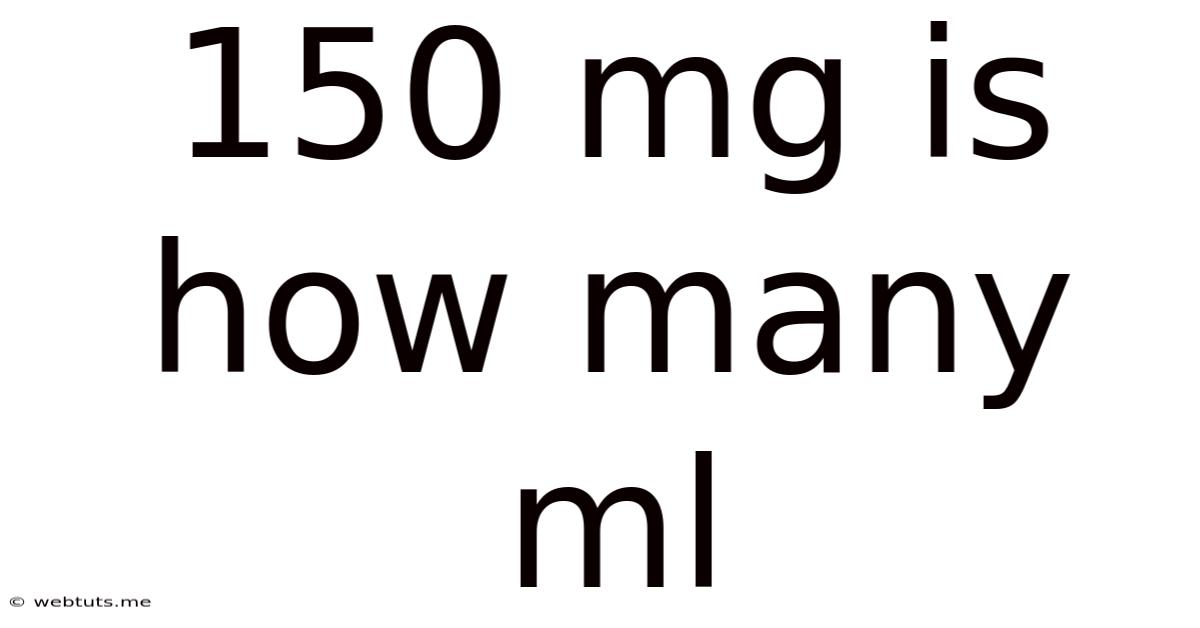150 Mg Is How Many Ml
Webtuts
May 10, 2025 · 4 min read

Table of Contents
150 mg is How Many ml? Understanding Dosage and Volume Conversions
The question "150 mg is how many ml?" is a common one, particularly in medicine and other fields dealing with precise measurements. However, there's no single, universally correct answer. The conversion between milligrams (mg), a unit of mass, and milliliters (ml), a unit of volume, depends entirely on the density of the substance in question. Density is the mass per unit volume, often expressed as grams per milliliter (g/ml) or kilograms per liter (kg/l).
This article will delve into the complexities of this conversion, exploring the underlying principles, providing examples, and highlighting the crucial importance of accurate measurement in various contexts. We'll also address common misconceptions and offer guidance on how to perform these conversions correctly.
Understanding Units of Measurement: mg and ml
Before diving into the conversion, let's clarify the units involved:
-
Milligrams (mg): A unit of mass in the metric system. One milligram is one-thousandth of a gram (1 mg = 0.001 g). Mass refers to the amount of matter in an object.
-
Milliliters (ml): A unit of volume in the metric system. One milliliter is one-thousandth of a liter (1 ml = 0.001 l). Volume refers to the amount of space occupied by an object or substance.
Why You Can't Directly Convert mg to ml
The key to understanding why a direct conversion isn't possible lies in the concept of density. Different substances have different densities. For example:
-
Water: Has a density of approximately 1 g/ml (or 1 kg/l). This means 1 gram of water occupies a volume of 1 milliliter.
-
Oil: Has a density less than 1 g/ml. A gram of oil will occupy a larger volume than a gram of water.
-
Mercury: Has a density significantly greater than 1 g/ml. A gram of mercury will occupy a much smaller volume than a gram of water.
Therefore, to convert 150 mg to ml, you must know the density of the substance.
The Formula for Conversion
The formula for converting mass (in mg) to volume (in ml) is:
Volume (ml) = Mass (mg) / (Density (g/ml) * 1000)
We multiply the density by 1000 because density is usually expressed in g/ml, and we need to convert mg to g.
Examples of mg to ml Conversion
Let's illustrate this with a few examples:
Example 1: Converting 150 mg of Water to ml
- Mass (mg) = 150 mg
- Density (g/ml) = 1 g/ml (approximately, for water)
Volume (ml) = 150 mg / (1 g/ml * 1000) = 0.15 ml
Therefore, 150 mg of water is approximately 0.15 ml.
Example 2: Converting 150 mg of a Substance with Density 0.8 g/ml to ml
- Mass (mg) = 150 mg
- Density (g/ml) = 0.8 g/ml
Volume (ml) = 150 mg / (0.8 g/ml * 1000) = 0.1875 ml
Therefore, 150 mg of this substance is approximately 0.1875 ml.
Example 3: Converting 150 mg of a Substance with Density 2 g/ml to ml
- Mass (mg) = 150 mg
- Density (g/ml) = 2 g/ml
Volume (ml) = 150 mg / (2 g/ml * 1000) = 0.075 ml
Therefore, 150 mg of this substance is approximately 0.075 ml.
Importance of Accurate Measurement in Medicine and Other Fields
Accurate measurement is paramount in various fields, particularly in medicine and pharmaceuticals. Incorrect conversion of mg to ml can lead to serious consequences, including:
- Medication Errors: Administering an incorrect dosage can have severe health repercussions.
- Scientific Experiments: Inaccurate measurements can compromise the validity and reproducibility of experimental results.
- Industrial Processes: In manufacturing, precise measurements are critical for quality control and product consistency.
Common Misconceptions
It's crucial to dispel some common misconceptions:
- Assuming a fixed conversion factor: There's no universal conversion factor between mg and ml. The conversion always depends on the density of the substance.
- Ignoring density: This is the most common and dangerous mistake. Always account for the density of the substance you're working with.
Practical Applications and Further Considerations
The conversion of mg to ml has various practical applications:
- Medicine: Calculating medication dosages based on concentration and volume.
- Chemistry: Determining the volume of a solution needed for a reaction based on the mass of a reactant.
- Food Science: Calculating the volume of ingredients needed in recipes based on their weight.
Furthermore, consider these points:
- Temperature: Density can be affected by temperature. For precise conversions, the temperature should be specified.
- Concentration: For solutions, the concentration (e.g., % w/v, molarity) is crucial. The density of a solution will vary with its concentration.
- Units: Always double-check the units to ensure consistency throughout your calculations.
Conclusion: The Importance of Context and Density
In conclusion, there's no simple answer to "150 mg is how many ml?". The conversion requires knowledge of the substance's density. This article emphasizes the crucial role of density in these conversions and highlights the potential consequences of inaccurate measurements. Always remember to use the correct formula and consider relevant factors like temperature and concentration for precise conversions. Accurate measurements are essential for safety, accuracy, and reliability in various fields. Always consult relevant sources and professionals when dealing with precise measurements, especially in medical contexts.
Latest Posts
Latest Posts
-
1 Pint Is How Many Lbs
May 10, 2025
-
How Many More Days Till July 16th
May 10, 2025
-
How Fast Is Mach 3 In Miles Per Hour
May 10, 2025
-
How Many Oz Is 475 Ml
May 10, 2025
-
How Many Knots Is The Speed Of Sound
May 10, 2025
Related Post
Thank you for visiting our website which covers about 150 Mg Is How Many Ml . We hope the information provided has been useful to you. Feel free to contact us if you have any questions or need further assistance. See you next time and don't miss to bookmark.